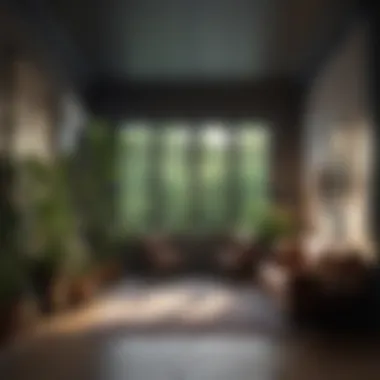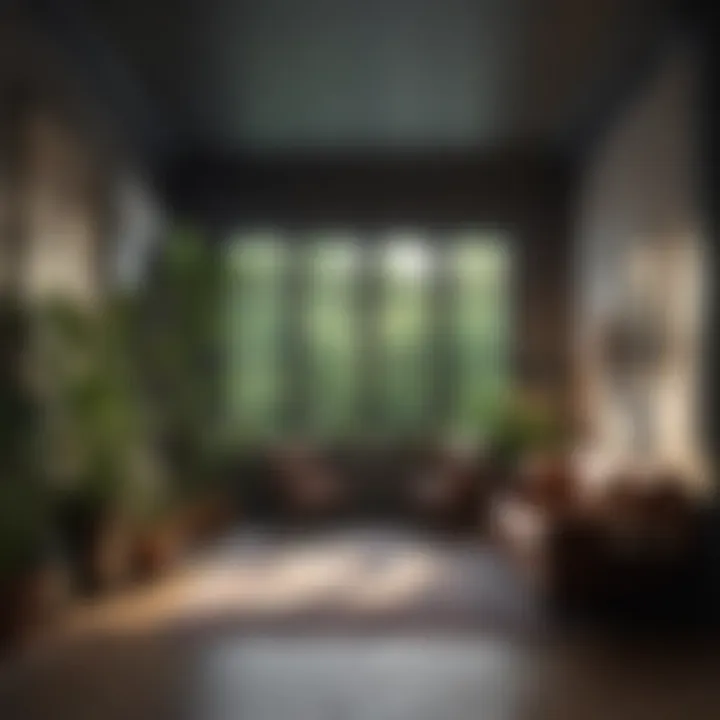Illumination Dynamics: Transforming Dark Spaces


Intro
Light has a profound impact on our perception of space and ambiance. In a dark room, the judicious introduction of light can convert it into a welcoming environment. This article examines both practical and aesthetic aspects of lighting designs, specifically focusing on how illumination can transform dark spaces into functional areas. The interplay between light and dark not only affects our physical surroundings but also influences our emotional and psychological responses.
This exploration will detail various lighting techniques, the psychology behind light use, and practical applications for homeowners, interior design enthusiasts, and hosts looking to enhance their spaces. We aim to equip readers with insights into creating inviting atmospheres through careful light management.
Design Inspiration
Trending Styles
Understanding the latest trends in lighting can provide inspiration and direction for transforming dark rooms. Designs today often prioritize simplicity and functionality, focusing on clean lines and minimalist aesthetics. Popular styles include:
- Modern: Features sleek fixtures, often with integrated LED technology.
- Industrial: Incorporates raw materials and exposed bulbs for a rugged charm.
- Scandinavian: Emphasizes natural light and soft palettes to create a cozy atmosphere.
These trends serve not only to beautify spaces but also to enhance their functionality. Utilizing appropriate styles can significantly impact the mood and usability of a room, making it essential to choose light fixtures that align with the desired ambiance.
Color Palettes
When selecting colors for a dark space, it is crucial to consider how they interact with light. Certain colors can amplify light, while others absorb it. For instance, light or pastel shades can help reflect light and brighten a room, while darker hues can create a more intimate or dramatic environment.
Effective combinations may include:
- Soft whites and creams to enhance brightness.
- Earthy tones like terracotta and olive green for warmth.
- Deep blues or greens for sophistication and depth, complemented with strategic lighting.
Choosing the right color palette can dramatically affect how light is perceived in a room, making it a key consideration in the design process.
Practical Tips
Maintenance & Care
Maintaining light fixtures is essential to ensure they function optimally. Regular cleaning prevents dust accumulation that can reduce brightness. Here are some tips for upkeep:
- Dust fixtures regularly using a soft cloth.
- Replace bulbs promptly to maintain consistent lighting.
- Check for wiring issues or flickering lights that may need professional attention.
Taking these steps will help prolong the life of the fixtures and maintain the desired aesthetic in a room.
Budgeting & Planning
When planning a lighting overhaul, budget considerations are paramount. Determine what your priorities are and allocate funds accordingly. Possible strategies include:
- Investing in a few statement pieces rather than numerous smaller fixtures.
- Utilizing smart lighting technologies that allow for future upgrades or adjustments.
- Shopping sales or considering second-hand options to stay within budget without sacrificing style.
A well-planned approach ensures that your lighting choices enhance both the atmosphere and the functionality of your dark room without unnecessary financial strain.
"The only thing worse than being blind is having sight but no vision." - Helen Keller
In summary, the role of light in dark spaces extends beyond mere illumination. It influences our environment, impacts our emotions, and shapes our experiences, making it a critical element in interior design.
Understanding Light and Darkness
Light and darkness are not just physical phenomena, but pivotal elements that shape our environment and experience within various spaces. Their interplay significantly affects not only the aesthetic quality of a room but also influences human psychology and behavior. This section elucidates the critical importance of understanding light and darkness, as it lays the foundation for effective lighting design and usage.
The significance of light stretches beyond mere illumination; it is a medium through which spaces are defined and perceived. Natural and artificial light can transform an ordinary space into an inviting and functional environment. By comprehending how light works, homeowners and design enthusiasts can manipulate it to enhance ambiance, improve visibility, and create a desired mood. This understanding is especially important in dark areas where poor lighting can lead to feelings of discomfort or unease.
As we delve deeper into the characteristics of light and darkness, we can glean various benefits. Proper lighting can increase productivity and foster a welcoming atmosphere for family and guests. Moreover, considering the effects of light can aid in energy-efficient choices, promoting sustainability in design implementations.
In essence, a thorough grasp of the dynamics between light and darkness is not only beneficial but essential. As we explore the next sub-sections, we will unpack the nature of light itself and examine the psychological implications of darkness in our everyday lives.
The Nature of Light
Light, fundamentally, is an electromagnetic wave that enables visibility. It exists in various forms and interacts with surfaces differently. Light can be categorized into natural, typically sunlight, and artificial, which includes various sources like bulbs and neon lights. Each form has distinct qualities that can dramatically influence a space.
Understanding color temperature is also crucial. This attribute of light describes how warm or cool it appears and is measured in Kelvins. For instance, lower Kelvin values signify warmer lights that are cozy and inviting; conversely, higher Kelvin values produce cooler lights, imparting a more sterile or energizing effect. Such nuances contribute to how we perceive and operate in our surroundings.
In practical applications, light fixtures and their positioning can significantly affect the ambiance of a space. Different fixtures, from pendant lights to recessed lighting, can create diverse atmospheres tailored to the desired function of the room. Homeowners should consider themes such as how much light is needed, the room's purpose, and the potential contrasts created by shadows and brightness.
Psychology of Darkness
Darkness often evokes various emotional and psychological responses. In many cultures, darkness is associated with negativity or fear. However, in interior design, darkness can serve as a canvas that allows light to stand out, creating dramatic contrasts and depth.
From a psychological standpoint, spaces with insufficient light may instill discomfort or anxiety. Conversely, well-planned lighting can provide warmth and safety, helping individuals feel more at ease in their environments. Therefore, understanding how to balance light and darkness is essential for creating supportive living spaces.
Moreover, the context of darkness plays a role in how individuals interact with their surroundings. For instance, in a cozy bedroom setting, softer light may promote relaxation, whereas brighter light is often necessary in workspaces to encourage focus. Recognizing these relationships enables homeowners and design enthusiasts to make informed choices that enhance the functionality and comfort of their spaces.


"Light is not just a tool for visibility; it is an essential element that shapes perception, mood, and behavior."
This exploration into the nature of light and the psychology of darkness underscores the necessity of thoughtful light design within interiors. With these insights, homeowners can move toward creating spaces that not only illuminate but also invite and inspire.
Types of Lighting Applications
Lighting serves multiple functions in a room. In a dark setting, the application of light can dictate the mood, enhance visual appeal, and ensure functionality. Understanding the different ways light can be applied helps create environments that are both beautiful and practical. This section explores the three primary types of lighting applications: ambient, task, and accent lighting, each offering unique benefits that contribute to the overall effectiveness of illumination in a dark room.
Ambient Lighting
Ambient lighting acts as the foundation or general light source in a room. It establishes the overall atmosphere and is crucial for visibility. Ambient lighting primarily comes from overhead fixtures or wall-mounted sconces. This type of lighting diffuses evenly, reducing harsh shadows.
Key elements to consider include:
- Brightness Level: Ensuring the ambient light offers sufficient brightness while maintaining comfort. Too bright can create glare, while too dim can hinder visibility.
- Light Color: The color temperature of ambient light significantly impacts the room's mood. Warmer tones create a cozy atmosphere, while cooler tones promote alertness.
- Control Options: Using dimmers allows adjustment of brightness for different activities or times of day.
In dark rooms, a well-planned ambient lighting system not only fosters a comfortable environment but also forms the backdrop for other lighting types.
Task Lighting
Task lighting focuses on specific areas to facilitate tasks such as reading, cooking, or working. It provides concentrated illumination where it is needed most, ensuring safety and efficiency. This form of lighting can come from table lamps, under-cabinet lights, and wall-mounted fixtures.
When considering task lighting, focus on:
- Placement: Position lights to avoid shadows on work surfaces. For example, placing a desk lamp on the side opposite a dominant light source can eliminate glare.
- Functionality: Products like adjustable desk lamps offer versatility, allowing users to direct light precisely where needed.
- Brightness: Assess the required lumen output based on the task. Bright, focused light is essential for detailed work.
In dark spaces, effective task lighting ensures that no important activity becomes hampered by inadequate visibility.
Accent Lighting
Accent lighting adds drama and interest to a room. It enhances architectural features, artworks, or plants by creating focal points through contrasting illumination. This type of lighting draws attention and can dynamically transform how a space is perceived.
Considerations for implementing accent lighting include:
- Light Positioning: Spotlights aimed at art pieces or indirect lighting behind furniture can create enticing visual effects.
- Brightness Levels: Accent lights should be brighter than ambient lights for effective highlighting. However, balance is crucial to avoid overpowering the room's primary lighting.
- Color Effects: Some accent lights can use colored bulbs to create unique atmospheres, adding to the overall aesthetic.
Effective use of accent lighting in a dark room can lead to a visually appealing and engaging environment that enhances the inner beauty of a space.
Ultimately, combining these lighting types creates a layered illumination strategy that addresses both functionality and aesthetics in dark areas. The right balance can transform rooms from simply functional to inviting and inspiring.
Architectural Considerations
The architectural design of a room plays a vital role in determining the quality and effectiveness of lighting. This aspect goes beyond cosmetic appeal; it directly influences how light interacts with the space, creating an atmosphere that can either enhance or detract from the functionality of the area. The arrangement and shape of a room, as well as its structural elements, can significantly modify the dynamics of illumination. Therefore, understanding architectural considerations is essential for homeowners and designers aiming to create a well-lit and inviting environment.
Positioning of Light Sources
The positioning of light sources is critical to ensure that light is distributed evenly and effectively. Placing lights in the right locations can brighten dark corners and eliminate shadows, which might otherwise create a dull effect. Overhead fixtures should be mounted at a height that provides adequate coverage while avoiding glare. Task lights, such as desk or bedside lamps, should be strategically placed to direct light precisely where it is needed.
In addition to function, aesthetics plays a role in positioning. Incorporating fixtures into the architecture, rather than having them as an afterthought, can enhance the design. Designers must also consider how light sources interact with architectural features. For instance, wall sconces can highlight textures or colors in materials, enhancing the visual appeal of a space.
Ceiling Height and Light Distribution
The height of the ceiling has a profound impact on how light is distributed within a room. Higher ceilings allow for more light fixtures, which can improve overall brightness. However, they can also cause light to disperse too much, making it harder to achieve a cozy atmosphere.
Conversely, lower ceilings might feel intimate but can produce a more oppressive feel if not well lit. In these cases, utilizing wall-mounted fixtures or recessed lighting can help maintain brightness without overcrowding the space. Additionally, reflectors and diffusers can enhance light distribution from fixtures, creating a more balanced illumination throughout the room.
Window Placement and Natural Light
Natural light is an often-overlooked element in lighting design. The placement of windows directly affects how light enters a space and plays a crucial role in defining the room's atmosphere. Rooms with ample window space can benefit from increased sunlight during the day, which serves to uplift mood and provide an inviting feel.
Thoughtful consideration should be given to the size and orientation of windows. South-facing windows typically capture sunlight for longer periods, while north-facing windows can offer softer, diffused light. In regions with extreme sunlight, implementing shades or curtains can help control brightness without sacrificing the benefits of natural light. Furthermore, strategically reflected light from mirrors or shiny surfaces can help disperse daylight deeper into the room.
Conclusion: Architectural considerations are paramount in leveraging the role of lighting within interior spaces. The placement of light sources, the height of the ceiling, and the positioning of windows all contribute to the luminosity and functionality of a room, making it a crucial aspect of design for homeowners and interior enthusists alike.
Light Manipulation Techniques
Understanding light manipulation techniques is crucial when discussing how to optimize illumination in dark rooms. These techniques are geared toward enhancing the effectiveness of lighting in various environments. Not only can they improve visibility, but they can also play a significant role in shaping mood and spatial perception. Using the right strategies allows for the transformation of a space from dreary and uninspired to welcoming and functional.
Using Reflective Surfaces
Reflective surfaces can be an excellent resource for maximizing light distribution in a dark room. Surfaces like mirrors, glossy paint, or metallic decor significantly bounce light around the space. This can create an illusion of depth and brightness. When choosing reflective surfaces, consider the following:
- Placement: Where mirrors or reflective panels are situated can enhance efficient light use.
- Finish: Glossy finishes reflect more light than flat finishes.
- Color: Lighter colors will amplify light better than darker shades.


By using strategic placement of reflective items, homeowners can brighten areas without necessarily adding more light fixtures, making it an efficient option. This approach offers substantial benefits in rooms where space is limited or when budget constraints exist.
Choosing the Right Fixtures
Choosing appropriate light fixtures is vital in achieving the desired lighting effect. Different styles and functionalities can influence how light is distributed in a room:
- Overhead Fixtures: These can provide general illumination, making them essential for dark spaces.
- Spotlights: Ideal for accent lighting, focusing on specific areas or objects. They can be intriguing for showcasing art or architectural details.
- Floor and Table Lamps: Flexible and movable options that add both light and decor. Their placement can adjust the ambiance easily.
Ensure that fixtures complement the room’s design while meeting lighting needs. Energy-efficient bulbs can also reduce consumption costs, presenting a more sustainable choice for homeowners.
Color Temperature and Its Impacts
Color temperature plays a significant role in how light is perceived. This measurement, usually defined in Kelvins (K), affects the ambiance and feel of a space. Here are the key aspects to consider:
- Warm White (2700K - 3000K): This range produces a cozy atmosphere, suitable for living rooms or bedrooms.
- Neutral White (3500K - 4100K): Works well in areas like kitchens and bathrooms, providing clearer visibility.
- Cool White and Daylight (5000K - 6500K): These cooler shades are ideal for task lighting, enhancing alertness in workspaces.
Selecting the right color temperature can influence mood and functionality. Cooler lights tend to enhance focus, whereas warmer tones can create relaxation, thus allowing users to tailor their environment according to activity.
"Light is not only about visibility. It encapsulates mood and atmosphere; it crafts our experiences."
By implementing these techniques, homeowners can effectively manipulate light to their benefit. With the proper application of reflective surfaces, thoughtful fixture choices, and awareness of color temperature, even the darkest of rooms can become vibrant and functional.
Innovative Technologies in Lighting
Innovative technologies in lighting are transforming how we approach illumination dynamics in interior spaces. The advent of smart lighting systems and adaptive lighting solutions brings significant benefits to homeowners and interior design enthusiasts alike. These technologies not only enhance the aesthetic appeal of a dark room but also improve functionality and efficiency. As we delve into these subcategories, it's essential to understand their implications for modern living environments.
Smart Lighting Systems
Smart lighting systems represent a significant leap forward in home illumination. They enable users to control their lighting environment through mobile applications, voice commands, or automated setups. This flexibility allows for the precise adjustment of brightness and color according to user preferences or activities.
Benefits of smart lighting systems include:
- Energy Efficiency: Many smart lighting options, such as LED bulbs, consume less power compared to traditional incandescent bulbs. This results in lower electricity bills and a reduced carbon footprint.
- Customization: Homeowners can create specific lighting scenes that cater to various activities, whether it is a relaxing evening with dimmed lights or a vibrant gathering with brighter settings.
- Remote Access: Being able to control lights from afar adds both convenience and security. Homeowners can program lights to turn on or off while away, dissuading potential intruders.
Considerations include the initial cost of installation and ensuring compatibility with existing home systems. Picking the right smart lighting system requires careful planning and research to achieve optimal results.
Adaptive Lighting Solutions
Adaptive lighting solutions provide dynamic light adjustments based on environmental conditions or personal preferences. This technology can automatically modify intensity and color temperature to correspond with the time of day or specific tasks.
Key features include:
- Circadian Rhythm Support: Some adaptive systems are designed to align with the body's natural sleep-wake cycle. These systems adjust their output throughout the day, promoting health and well-being by fostering a more natural indoor environment.
- Task-Specific Adjustments: Whether working on a detailed project or reading a book, the ability to alter light settings for specific needs can greatly enhance productivity.
- Energy Management: By adapting lighting based on natural daylight availability, these solutions contribute to energy savings and can be tailored for nighttime use, which is particularly beneficial for dark rooms.
Incorporating these innovative technologies in lighting can help create spaces that are not only visually appealing but also functional and comfortable. As homeowners embrace these advancements, they can find their dark rooms transformed into environments that promote activities and foster overall well-being.
Impact on Mood and Functionality
The role of lighting in shaping mood and functionality cannot be overstated. Effective illumination enhances the overall atmosphere of a room, often bridging the gap between aesthetics and practical use. This section delves into how light influences human behavior and the interplay between illumination and task performance.
Light and Human Behavior
Light has a remarkable ability to affect emotions and carry psychological implications. When a room is brightly lit, it tends to foster feelings of energy and vitality. In contrast, dim lighting can create a more tranquil or somber environment. For homeowners, understanding these distinctions can lead to better design choices that match the intended purpose of a space.
Consider the following points:
- Circadian Rhythms: The human body operates on a natural cycle influenced by light. Exposure to natural daylight helps regulate sleep patterns and overall mood. Creating spaces that maximize exposure to daylight can improve health.
- Color Temperature: Cool white light often appears energizing, while warm white LED can evoke comfort. Choosing the right temperature can significantly affect how people feel in a space.
- Lighting Levels: Too bright or too dim can lead to discomfort and fatigue. Finding the right balance is key to maintaining focus and improving mood.
"Light not only illuminates our physical environment but also our mental and emotional landscapes."
When designing interiors, one must consider how each lighting choice contributes to mood regulation. For instance, soft lighting is ideal for relaxation areas, whereas brighter lights are better suited for workspaces.
Creating Functional Spaces with Light
The design of any room should not merely focus on aesthetics; functionality is equally vital. Light can be a transformative asset in making spaces more usable and inviting. Here’s how appropriate lighting supports daily activities:
- Task Orientation: Different tasks require different lighting. Areas for reading or detailed work benefit from concentrated brightness, while general spaces like hallways need ambient lighting for safe navigation.
- Versatility: Using layered lighting techniques helps transition spaces according to need. For instance, adjustable fixtures can enhance the adaptability of a room.
- Highlighting Key Features: Accent lighting can draw attention to artwork or architectural details, allowing those elements to contribute to the space's functionality.
Design Strategies for Dark Rooms
The concept of design strategies for dark rooms is crucial in creating environments where light plays an essential role. A dark room can sometimes feel claustrophobic or barren, but it can be transformed into an inviting space through thoughtful design choices. Effective strategies focus on the placement, type, and control of light sources, supporting the goal of not just illumination but also enhancing mood and functionality.
When designing for dark rooms, consider the balance between natural and artificial lighting. Adequate planning helps create layers of light that can shift the atmosphere of a room from dark to light. This can be beneficial in making spaces feel larger and more inviting, an important aspect for homeowners and interior design enthusiasts alike. Moreover, a well-thought-out lighting scheme addresses considerations such as energy efficiency and adaptability to various activities, from relaxation to social gatherings.


Layering Light in Design
Layering light refers to the strategic use of multiple levels and types of lighting within a space. This method includes ambient, task, and accent lighting, all of which collectively enhance the visual aesthetics and functionality of a dark room. Here’s how each type contributes:
- Ambient Lighting: This serves as the primary light source, casting an overall glow throughout the room. Options like ceiling-mounted fixtures or chandeliers can help disperse light evenly.
- Task Lighting: This is focused illumination for specific areas, such as reading nooks or workspaces. Desk lamps or wall-mounted sconces enhance usability without overwhelming the main lighting scheme.
- Accent Lighting: This type creates focal points, drawing attention to artworks, architectural features, or plants. Mini spotlights can be effective in highlighting these elements.
By integrating these various layers of light, a homeowner or designer can manipulate a room’s perception significantly. Proper layering creates visual interest and depth, lending character to spaces often overshadowed by darkness.
"A well-lit room does not merely illuminate; it transforms spaces and elevates experiences."
Utilizing Textiles and Color
The choice of textiles and colors in a dark room plays an important role in how light is perceived. Materials like sheer curtains can allow natural light to filter in while maintaining privacy. Lighter colors on walls and furnishings create a sense of openness and reflect light better than darker shades, providing an illusion of a brighter space.
Moreover, incorporating textures can enhance this effect. Using cushions, rugs, and wall hangings in various textures adds depth and richness to a room, making it not just illuminated, but also comfortable and inviting. In addition:
- Darker textiles can absorb light, helping to create coziness but must be balanced carefully to avoid overpowering brightness.
- Bright colors, on the other hand, can invigorate a dark room, making it feel fresh and lively.
Ultimately, the combination of textiles and color must consider the overall design scheme. This is especially essential for party hosts or users wanting multi-functional spaces. By paying attention to these details, achieving a harmonious balance between light and dark becomes attainable.
Practical Considerations for Homeowners
Understanding the practical considerations for homeowners in the context of lighting design is essential. Effective lighting improves not only the aesthetic appeal of a space but also its functionality and energy efficiency. When approaching the task of upgrading or maintaining lighting systems in a home, homeowners must consider several aspects to avoid overspending and ensure pleasant lighting.
Budgeting for Lighting Upgrades
When it comes to budgeting for lighting upgrades, clarity is key. First, determine the areas that need improvement. Not all rooms require the same level of illumination or type of fixtures. Prioritize areas like kitchens and workspaces where task lighting is vital, or living areas that benefit from ambient lighting.
Additionally, homeowners should consider the styles and types of fixtures that complement their interiors. For instance, recessed lighting or pendant fixtures each have different costs associated with purchasing and installation.
Here are a few steps to consider:
- Set a budget range: Decide how much can be spent on lighting upgrades, including both fixtures and installation.
- Research fixture prices: Look up popular brands or locally available options. This helps in understanding costs better and avoiding unexpected expenses.
- Consider energy-efficient options: These may have a higher upfront cost, but they significantly lower long-term utility bills. Examples include LED bulbs or smart lighting which can adjust to user preference and reduce power consumption.
- Plan for installation costs: Hiring professionals may ensure proper installation but can also increase total expenses. Consider DIY options if you have the skills and comfort level.
Ultimately, an effective budget helps in making informed decisions, ensuring that upgrades enhance both aesthetic and practical value.
Maintenance of Lighting Systems
Maintaining lighting systems is as important as the initial installation. Regular maintenance prevents issues and extends the life of fixtures. Neglecting maintenance may lead to increased costs over time.
Here are key points for effective maintenance:
- Regular bulb checks: Swap out burned-out bulbs promptly. This ensures optimum light output and energy efficiency.
- Clean fixtures frequently: Dust and grime can significantly reduce the efficiency of lighting. Regular cleaning of light fixtures helps in maintaining brightness.
- Inspect wiring and connections: Older homes may have wear and tear in electrical systems. Regular inspection can catch potential faults before they lead to major issues.
- Adjustments for practical functionality: As needs change, so should lighting. Adding dimmer switches or varying light temperatures can enhance mood or functionality as needed.
Cultural Perspectives on Light
Light has played a significant role throughout human history, not only as a physical phenomenon but also as a cultural symbol. This section discusses how different cultures interpret and utilize light in their environments. Understanding these cultural perspectives is crucial when examining the dynamics of light in interior spaces. Homeowners and design enthusiasts can draw inspiration from diverse traditions to create spaces that resonate with personal values and societal beliefs.
Light in Various Cultures
Different cultures view light through unique lenses. For instance, in many Asian cultures, light symbolizes purity and enlightenment. In places like Japan, minimalism and the use of natural light are fundamental to aesthetics in architecture. Shoji screens, which diffuse light gently into spaces, reflect a harmonious relationship with nature, emphasizing tranquility.
In contrast, Western cultures might associate light with knowledge and power. Historically, in ancient Greece and Rome, temples were designed to capture sunlight, showcasing the power of the divine. The grand windows of Gothic cathedrals also signify this cultural connection, where light acts as a vehicle for spiritual experience.
Contemporary practices include the use of light in festivals, such as Diwali in India, where lights symbolize the victory of light over darkness. Understanding these cultural dimensions allows for a richer interpretation of light in modern design choices, pushing beyond mere functionality.
Influence of Light in Different Design Styles
The influence of light varies widely among different design styles, shaping how spaces are both perceived and experienced. Traditional styles often emphasize ornate lighting fixtures like chandeliers in classical settings, enhancing the grandeur of rooms. The interplay of shadows and light contributes to a warm and inviting ambiance.
In contrast, minimalist designs often prioritize open spaces with ample natural light. The concept of 'bringing the outdoors in' is prominent in Scandinavian design, where large windows and light colors dominate the aesthetic. This approach fosters a sense of calm and connection to the environment.
Modern design trends, influenced by technology, often incorporate smart lighting solutions. These allow homeowners to customize light settings, impacting mood and functionality in real time. With such advances, designers can manipulate perceptions of space through strategic use of light, catering to contemporary lifestyles.
"Understanding the cultural significance of light can elevate interior design from mere decoration to a powerful form of expression."
In summary, exploring cultural perspectives on light offers valuable insights into its multifaceted role in design. By integrating these ideas, individuals can create spaces that reflect both personal identity and collective heritage.
Future Directions in Lighting Design
As we progress in the field of lighting design, it’s crucial to consider future trends that will shape our living environments. The importance of sustainable and innovative lighting solutions cannot be overstated. Homeowners, interior designers, and enthusiasts are increasingly aware of the impacts that lighting can have not just on ambiance, but also on energy consumption and overall well-being.
Sustainable Lighting Practices
Sustainable lighting practices are essential for ensuring efficiency and reducing environmental impact. Integrating sustainable options into lighting design addresses two key concerns: environmental responsibility and economic viability. Here are several important elements of sustainable lighting:
- Energy Efficiency: Utilizing LED technology is a prime aspect. These lights consume less power and have longer lifespans than traditional bulbs, leading to significant cost savings over time.
- Natural Light Utilization: Designing spaces to maximize natural light reduces the need for artificial illumination during daylight hours. This not only saves energy but positively influences mood and productivity.
- Smart Lighting Controls: Implementing systems that can adjust brightness based on occupancy and time of day allows for bespoke lighting that changes in response to actual needs, leading to enhanced efficiency.
- Recyclable Materials: Choosing lighting fixtures made from recyclable materials contributes to sustainability. This practice encourages a circular economy where resources are reused.
Adopting these practices aligns with the growing emphasis on environmental stewardship. Beyond ecological impacts, sustainable lighting practices also encompass the well-being of inhabitants.
"Sustainable lighting choices enhance both the environment and the user experience, making spaces more livable and responsible."















